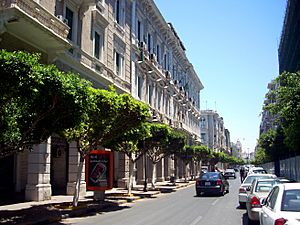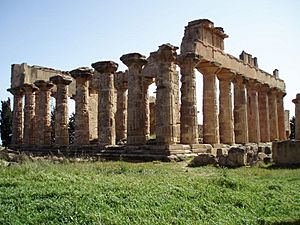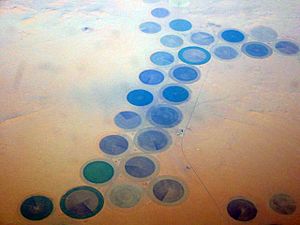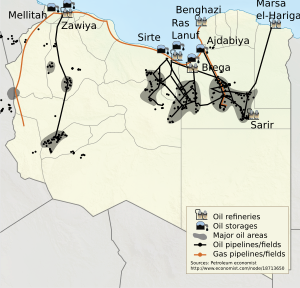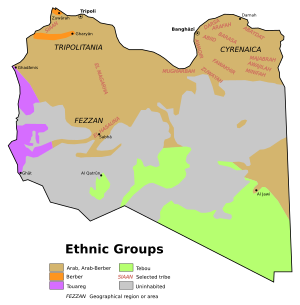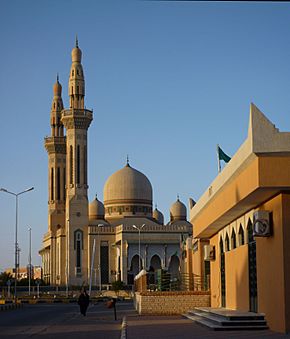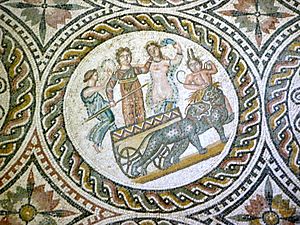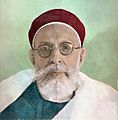Libya facts for kids
Quick facts for kids
State of Libya
|
|
|---|---|
|
Anthem: ليبيا، ليبيا، ليبيا
"Libya, Libya, Libya" |
|
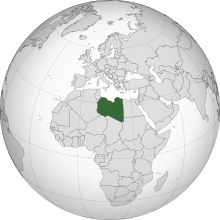
Location of Libya (dark green) in northern Africa
|
|
| Capital and largest city
|
Tripoli 32°52′N 13°11′E / 32.867°N 13.183°E |
| Official languages | Arabic |
| Local vernacular | Libyan Arabic |
| Ethnic groups
(1999)
|
|
| Religion
(2020)
|
|
| Demonym(s) | Libyan |
| Government | Unitary republic under a provisional government |
|
• Chairman of the Presidential Council
|
Mohamed al-Menfi |
|
• Vice Chairman of the Presidential Council
|
Musa Al-Koni |
| Abdul Hamid Dbeibeh | |
| Legislature | House of Representatives |
| Establishment | |
|
• Regency of Tripoli
|
15 August 1551 |
| 5 November 1911 | |
|
• Independence declared
|
10 February 1947 |
|
• Kingdom established
|
24 December 1951 |
|
• Coup d'état by Muammar Gaddafi
|
1 September 1969 |
| 2 March 1977 | |
| 17 February 2011 | |
|
• NATO intervention in Libya
|
19 March 2011 |
| 23 October 2020 | |
| Area | |
|
• Total
|
1,759,541 km2 (679,363 sq mi) (16th) |
| Population | |
|
• 2024 estimate
|
7,361,263 (103rd) |
|
• Density
|
4.184/km2 (10.8/sq mi) (218th) |
| GDP (PPP) | 2024 estimate |
|
• Total
|
|
|
• Per capita
|
|
| GDP (nominal) | 2024 estimate |
|
• Total
|
|
|
• Per capita
|
|
| HDI (2022) | high · 92nd |
| Currency | Libyan dinar (LYD) |
| Time zone | UTC+2 (EET) |
| Driving side | right |
| Calling code | +218 |
| ISO 3166 code | LY |
| Internet TLD | .ly ليبيا. |
|
|
Libya (Arabic: ليبيا Lībyā, Berber: ⵍⵉⴱⵢⴰ Libya), officially the State of Libya, is a country in North Africa. It is bordered by the Mediterranean Sea to the north, Egypt to the east, Sudan to the southeast, Chad and Niger to the south, and Algeria and Tunisia to the west. It covers an area of almost 1.8 million square kilometres (700,000 sq mi). This makes it the 17th largest country in the world.
Contents
Libya's Long History
Libya has been home to people for a very long time. The Berbers have lived there since the late Bronze Age. Later, ancient civilizations like the Phoenicians and Greeks built cities and trading posts along the coast.
Parts of Libya were ruled by different empires, including the Roman Empire. Libya was one of the first places where Christianity spread. After the Roman Empire declined, the area was taken over by the Vandals. In the 7th century, Islam came to the region through invasions. Over time, many Arabs moved to Libya, changing its population.
In the 16th century, the Ottoman Empire took control of Libya in 1551. This rule lasted until the Italo-Turkish War in the early 1900s. After this war, Italy took over Libya, making it an Italian colony from 1911 to 1943.
During World War II, Libya was a major battleground in the North African Campaign. After the war, the number of Italian settlers in Libya decreased.
Becoming an Independent Kingdom
After World War II, parts of Libya were controlled by Britain and France. In 1951, the United Nations helped Libya become an independent country called the United Kingdom of Libya. It was set up as a constitutional monarchy, which means it had a king but also a constitution to guide the government.
King Idris I became the first king on December 24, 1951. He had been a leader in the Cyrenaica region and helped unite Libya's three main areas.
Libya faced many challenges at independence. It was a very poor country with few resources to sell. Most people could not read, and there were very few doctors or engineers. Many people also suffered from eye diseases.
The government was seen as not doing enough to help the country. However, when oil was discovered, Libya became one of the world's largest oil producers. This brought a lot of money, but many Libyans felt the money was not shared fairly.
The Libyan Arab Republic
On September 1, 1969, a group of military officers took control of the government in a coup d'état (a sudden takeover). Colonel Muammar al-Gaddafi became the new leader. He wanted to create a new political system for Libya.
Gaddafi took back control of Libya's oil resources. He also asked the remaining Italian settlers to return to Italy and closed a large American air force base.
The Great Socialist People's Libyan Arab Jamahiriya
In 1977, Libya's official name became "The Great Socialist People's Libyan Arab Jamahiriya."
Under Gaddafi's rule, Libya had tense relations with some Western countries. This was because Libya supported various groups around the world. For example, Libya provided support to groups like Nelson Mandela's African National Congress and the Palestine Liberation Organization.
Because of these actions, the United Nations placed economic sanctions on Libya in 1992. These sanctions stopped other countries from selling weapons to Libya or investing money there.
Later, Gaddafi decided to change Libya's approach. He agreed to stop developing certain weapons programs and allowed international experts to check. The UN then removed the sanctions. Libya also paid money to the families of victims from a plane crash over Lockerbie, Scotland, in 1988, to resolve the issue.
Gaddafi also worked to improve relations with other countries. He visited Western Europe and reconnected with Russia. He ruled Libya for 42 years.
In 2011, a conflict known as the First Libyan Civil War led to Gaddafi being overthrown and killed. After this, two different groups claimed to govern Libya, leading to a Second Libyan Civil War from 2014 to 2020. In 2020, the main groups signed a ceasefire. Now, a unity government is working to prepare for democratic elections, though political disagreements still exist.
Libya's Geography
Libya shares its borders with Egypt, Sudan, Chad, Algeria, Niger, and Tunisia. To the north is the Mediterranean Sea. The capital of Libya is Tripoli, which is a port city on the sea. Tripoli is home to about one million people. Libya covers a large area of about 1,760,000 km2 (679,540 sq mi).
The highest point in Libya is Bikku Bitti, which is 2,267 meters (7,438 feet) above sea level. The lowest point is Sabkhat Ghuzayyil, which is 47 meters (154 feet) below sea level. Most of Libya is flat, with large plains. Because it is so dry, only a small part of the land (about 1%) can be used for farming.
Libya has three main historical regions:
- Tripolitania: This is the area around Tripoli in the west. It was the most developed during the Ottoman rule.
- Cyrenaica: This region is on the northeast coast. It is separated from Tripolitania by the Gulf of Sirte. The Greeks named it after the city of Cyrene, which they built in 630 BC. Many battles of World War II happened here. It includes the cities of Tobruk and Benghazi.
- Fezzan: This is a desert area in southwest Libya. After World War II, France governed this area for a time.
Libyan Districts
Since 2007, Libya has been divided into 22 districts. These districts help manage the country's different areas.
| Arabic | Transliteration | Pop (2006) | Land area (km2) | Number (on map) |
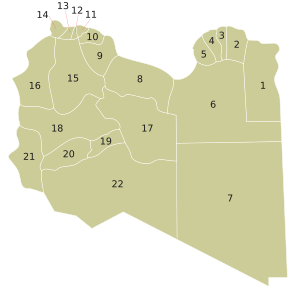 |
|---|---|---|---|---|---|
| البطنان | Butnan | 159,536 | 83,860 | 1 | |
| درنة | Derna | 163,351 | 19,630 | 2 | |
| الجبل الاخضر | Jabal al Akhdar | 206,180 | 7,800 | 3 | |
| المرج | Marj | 185,848 | 10,000 | 4 | |
| بنغازي | Benghazi | 670,797 | 43,535 | 5 | |
| الواحات | Al Wahat | 177,047 | 6 | ||
| الكفرة | Kufra | 50,104 | 483,510 | 7 | |
| سرت | Sirte | 141,378 | 77,660 | 8 | |
| مرزق | Murzuq | 78,621 | 349,790 | 22 | |
| سبها | Sabha | 134,162 | 15,330 | 19 | |
| وادي الحياة | Wadi al Hayaa | 76,858 | 31,890 | 20 | |
| مصراتة | Misrata | 550,938 | 9 | ||
| المرقب | Murqub | 432,202 | 10 | ||
| طرابلس | Tripoli | 1,065,405 | 11 | ||
| الجفارة | Jafara | 453,198 | 1,940 | 12 | |
| الزاوية | Zawiya | 290,993 | 2,890 | 13 | |
| النقاط الخمس | Nuqat al Khams | 287,662 | 5,250 | 14 | |
| الجبل الغربي | Jabal al Gharbi | 304,159 | 15 | ||
| نالوت | Nalut | 93,224 | 16 | ||
| غات | Ghat | 23,518 | 72,700 | 21 | |
| الجفرة | Jufra | 52,342 | 117,410 | 17 | |
| وادي الشاطئ | Wadi al Shatii | 78,532 | 97,160 | 18 |
Major Cities in Libya
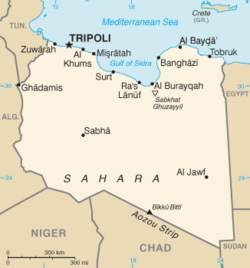
Libya has several important cities, mostly located along its coast.
- Tripoli - The capital and largest city.
- Benghazi - A major city in the east.
- Al Bayda
- Misratah
- Tobruk
Libya's Economy
Libya's economy relies mostly on its oil. Oil makes up more than half of the country's total economic output and 97% of its exports. Libya has the largest proven oil reserves in Africa.
The country faces some challenges, like not having enough strong institutions and high unemployment. Getting enough clean water is also a problem for some people.
The Great Man-Made River is a huge project that brings water from deep underground in southern Libya to cities on the northern coast, like Tripoli and Benghazi. This water provides 70% of all the fresh water used in Libya.
Libya imports most of its food, especially cereals like wheat. The government hopes to grow more food in the future, but the dry climate makes farming difficult.
Libya joined OPEC (Organization of the Petroleum Exporting Countries) in 1962. In the early 1980s, Libya was one of the richest countries in the world based on its GDP per person.
People and Population
Libya is a large country, but most of its people live along the coast. The population density is much higher in the northern regions of Tripolitania and Cyrenaica. About 90% of Libyans live in less than 10% of the country's total area.
Around 88% of the population lives in cities, mainly in Tripoli, Benghazi, and Misrata.
Most of Libya's population is of Arab background, making up about 92%. Berbers make up about 5%. While some Libyans still live in the desert following traditional ways, most work in industries and services.
Languages Spoken in Libya
The official language of Libya is Arabic. The local Libyan Arabic dialect is commonly spoken, along with Modern Standard Arabic. Various Berber languages are also spoken by some groups.
In major cities, English is widely understood. Italian, the language of the former colonial power, is also used in business and by the remaining Italian population.
Religion in Libya
About 97% of the people in Libya are Muslims. Most of them follow the Sunni branch of Islam. A small number of Ibadi Muslims also live in the country.
Libyan Culture

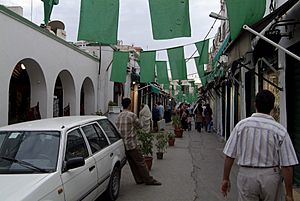
Many Arabic-speaking Libyans feel connected to a larger Arab community. This feeling grew stronger in the mid-20th century. During Gaddafi's rule, the teaching and use of native Berber languages were not allowed.
Libyans have a rich heritage from both nomadic Bedouin Arabs and settled Berber tribes. Many Libyans connect themselves to a specific family name that comes from their tribal history.
Libyans are known for their kindness and hospitality. In 2013, Libya was ranked among the top 20 countries in the world for giving. This means that many Libyans often help people they don't know.
There are not many public theaters or art galleries in Libya. For many years, there were very few cinemas showing foreign films. However, traditional folk culture is still very much alive. Music and dance groups perform at festivals both in Libya and abroad.
Many Libyan television stations focus on politics, Islamic topics, and cultural events. Some TV stations also play different styles of traditional Libyan music. Tuareg music and dance are popular in Ghadames and the southern parts of the country.
Libyans enjoy visiting the country's beaches and ancient sites. Leptis Magna is a famous Roman archaeological site that is very well preserved. The most common way to travel between cities is by bus, though many people use cars. There are plans to build railway services in the future.
Tripoli, Libya's capital, has many museums and archives. These include the Government Library, the Ethnographic Museum, the Archaeological Museum, and the Islamic Museum. The Red Castle Museum, located in the city center, is one of the country's most famous museums.
Libyan Cuisine
Libyan food is a mix of Italian, Bedouin, and traditional Arab cooking styles. In western Libya, pasta is a main food, while in the east, rice is more common.
Popular Libyan dishes include pasta with red (tomato) sauce, similar to Italian sauces. Rice is often served with lamb or chicken, which can be stewed, fried, grilled, or boiled in sauce. Couscous is also very common. It's steamed over boiling red (tomato) sauce with meat and vegetables like zucchini and chickpeas. It's usually served with cucumber slices, lettuce, and olives.
Bazeen is a dish made from barley flour, served with red tomato sauce. It's often eaten by several people sharing from the same dish, usually with their hands. This dish is popular at weddings and celebrations. Asida is a sweet version of Bazeen, made from white flour and served with honey or butter. Another way to eat Asida is with date syrup and olive oil.
Khubs bi' tun is a common snack: bread with tuna fish mixed with harissa (chili sauce) and olive oil. You can find these sandwiches from many street vendors across Libya.
Traditional Libyan food uses four main ingredients: olives (and olive oil), dates, grains, and milk. Grains are used to make bread, cakes, soups, and bazeen. Dates can be eaten fresh, dried, or made into syrup. After a meal, Libyans often drink black tea. It's usually served in three rounds, with the third round often including roasted peanuts or almonds mixed in the tea.
Sports in Libya
Football is the most popular sport in Libya. The country hosted the 1982 African Cup of Nations (AFCON) and almost made it to the 1986 FIFA World Cup. The national team nearly won the 1982 AFCON, losing to Ghana in a penalty shootout. In 2014, Libya won the African Nations Championship. Even though the national team hasn't won a major competition or qualified for a World Cup, there's a lot of passion for football, and the quality of play is getting better.
Horse racing is also a popular sport in Libya. It's a traditional activity for many special events and holidays.
Images for kids
-
The Atiq Mosque in Awjila is the oldest mosque in the Sahara.
-
The Siege of Tripoli in 1551 allowed the Ottomans to capture the city from the Knights of St. John.
-
The USS Enterprise of the Mediterranean Squadron capturing a Tripolitan Corsair during the First Barbary War, 1801
-
A US Navy expedition under Commodore Edward Preble engaging gunboats and fortifications in Tripoli, 1804
-
Omar Mukhtar was a prominent leader of Libyan resistance in Cyrenaica against Italian colonization.
-
King Idris I of the Senussi order became the first head of state of Libya in 1951.
-
Gaddafi (left) with Egyptian President Nasser in 1969
-
Libya has emerged as a major transit point for people trying to reach Europe
-
Field Marshal Khalifa Haftar, the head of the Libyan National Army, one of the main factions in the 2014 civil war.
-
Libyan men in Bayda.
See also
 In Spanish: Libia para niños
In Spanish: Libia para niños




